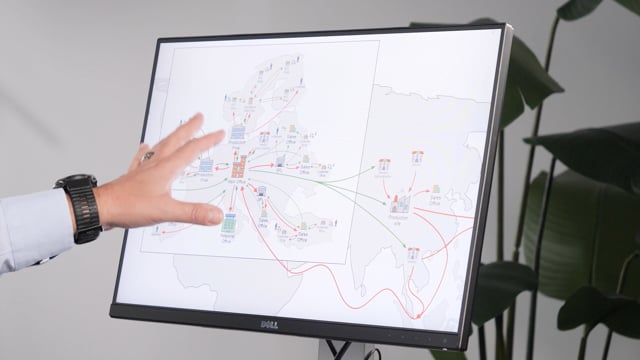
If I have a setup using more than one location, for instance, like on this picture, where I have a main office and manufacturing sites, vendors around the world and sales offices or even sales hubs, I would like to plan in a supply chain order, meaning I would like to plan in a backwards order going from the supply to the demands.
Often I would therefore like to plan the transfer orders first on the different location to transfer from my production location or main location or distribution location and likewise backwards.
In this example I will show you I will have one location my production location and I’m being a planner on that location.
So I would like to plan transfer orders for all the locations around it and then to plan production orders on my main location and then to plan purchase orders on that main location.
Of course, if I was sitting as a planner on one of the other locations, I would plan on that location first, both production orders, transfer orders and so on, depending on how that location is working.
Let’s see how you can use this in reverse planning in a simple way.
In Business Central, if I’m going into my simple MRP, you can, of course course just plan by yourself manually creating templates for setting filters to plan on transfer orders, then to plan on production orders, then to plan on purchase orders, or you can use some of the templates we have defined to do it.
Be aware of one thing which is that you cannot filter on replenishment system transfer order on the item card because you can only do that on a stock keeping unit card.
Therefore, on the planning template, a little down, we have the stock keeping unit filter template and the item filter template.
It works in a way where it says it takes the item filter template and only plan on the items within the item filter template.
And then afterwards, it applies the stock keeping unit filter template as well.
So in this template, I have a full, I call it a run transfer orders to safety stock.
And my item filter templates is defined like this.
I call it transfer items.
And the template in here, when I click it, is defined by my location I want to transfer in from.
It could also have been location code different from my production location.
And my stock keeping unit filter template in here says if I’m looking at this template, that replenishment system needs to be a replenishment system transfer only.
So only bring in the stock keeping unit with that replenishment system.
The next thing that is interesting is like I could plan on all low-level codes, meaning it will plan one iteration and then put it in the reverse planning worksheet again and again.
I can also plan with next template.
in the reverse planning worksheet and again and again.
I can also plan with next template so I can define other templates and plan down into those templates.
That means if I look at my template list and I have made those one, I could do it manually.
So if I’m doing it manually, I have to find here a list of template where I can run one template, then the next template, then the next template, then the next template.
And you can see here by the name of it, of course, I just figure out the name.
You can see I want to plan for plan transport orders first, then production order on level zero, production order on level one, et cetera, et cetera.
And in the end, purchase orders.
I also made some hidden templates and you can define them by yourself just by checkmarking the column.
When you say show hidden templates and you edit this view, you can define if they should be hidden or not out here.
It’s only a matter of overviewing it.
If you look at my templates that I call full transfer run or full transfer and then production order level one, two, three, four, five.
If you don’t have any on level three, four, five, it doesn’t matter.
And in the end purchase items.
And you can see on the right hand side here that the next template to run is the next one in that order.
So first, transfer orders, then production orders on level 0, production orders on level 1, et cetera.
So therefore, it’s an iteration.
And for each of the template, I can set up manually if it’s triggering on safety stock reorder point, what to include of demand and supplies, and so on.
Before I’m running it, I just want to check that I don’t have any lines in my reverse planning worksheet.
I don’t.
So this automatically batch job could be if you have many items or everything is set up smooth and you want to run this at night so it’s done when you show up in the morning.
You could set this up as a batch job in here.
So I will expect it to run on my location around my production location, only transfer orders, then on my production location for production orders, then for purchase orders on my production location.
And I’d like that to be in my reverse planning worksheet in a nice manner.
And they have been transferred directly from my simple MRP into the reverse planning worksheet because I’ve checkmarked the filling quantity, filling the suggested order quantity automatically and carried out.
Otherwise it wouldn’t break down the low-level code.
So as you can see here, transfer orders to all my different locations.
First of all, external location, Copenhagen, Newport, etc.
Then production orders on my main location down here, and then in the end, purchase orders on my main location.
So this way, it’s easier for me to overview the stuff in here.
And the reason for doing it in iteration and putting it directly in this journal is if I click for instance on my city bike line number two, it needs to create a component lines here in the journal.
So it needs to create the, oh sorry about this one, that’s a transfer order of course, so there’s no component line.
Let me show you on a production order here like this.
It needs to create the depending demand when you calculate further down the low-level code hierarchy.
So that’s what the MRP journal would normally do automatically.
Here it’s a little more manually.
And like I said, in real life, you often wouldn’t do it like this.
Just delete it.
You often wouldn’t do one big iteration like this.
You would do one step at a time.
So you would probably normally take a transfer order to safety stock manual journal, carry out that one into the reverse planning worksheet, then plan on production order level zero.
Look at the numbers, look if it fits to your capacity demands, et cetera, then carry out, et cetera.
So basically this is a way to plan in a very nice manner.

